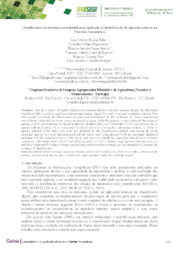Classificador de máxima verossimilhança aplicado à identificação de espécies nativas na Floresta Amazônica.
Classificador de máxima verossimilhança aplicado à identificação de espécies nativas na Floresta Amazônica.
Autoria: MORAS FILHO, L. O.; FIGUEIREDO, E. O.; ISAAC JÚNIOR, M. A.; BARROS, V. C. C. de; HOTT, M. C.; BORGES, L. A. C.
Resumo: Among a variety of digital classification methods based on remote sensing images, the Maximum Likelihood (ML) is widely used in environmental studies, mainly for land cover and vegetation analysis. This study aimed to evaluate the effectiveness of supervised classification by ML technique in a forest management area of dense ombrophilous forest, using one RapidEye image. With this purpose, it was conducted the census of species over 30 cm in diameter at breast height and calculated the Cover Value Index (CVI), and selected the 20 species with the highest CVI as a parameter for classification in a Geographic Information System. 13 of the 20 species selected in the study area were not identified by the classification method, and among the seven identified species, two were underestimated and the others were overestimated. Both the maximum likelihood technique and the spatial resolution of the image used were not suitable for supervised classification of native vegetation, with Kappa index of 0.05 and global accuracy of 5.53%. Studies using spectral characterization in leaf level supported by higher or hyper spectral and spatial resolution images are recommended to increase the accuracy of classification.
Ano de publicação: 2017
Tipo de publicação: Artigo em anais e proceedings
Unidade: Embrapa Acre
Palavras-chave: Acre, Amazonia Occidental, Amazônia Ocidental, Análise estatística, Análisis estadístico, Bosques tropicales, Especies nativas, Espécie nativa, Estimación, Estimation, Estimativa, Floresta tropical, Geographic information systems, Identificación de plantas, Identificação, Indigenous species, Manejo florestal, Maximum Likelihood, Máxima verossimilhança, Método de classificação digital, Método estatístico, Plant identification, Remote sensing, Rio Branco (AC), Sensoriamento remoto, Sistema de informação geográfica, Sistemas de información geográfica, Statistical analysis, Teledetección, Tropical forests, Western Amazon
Observações
1 - Por padrão são exibidas publicações dos últimos 20 anos. Para encontrar publicações mais antigas, configure o filtro ano de publicação, colocando o ano a partir do qual você deseja encontrar publicações. O filtro está na coluna da esquerda na busca acima.
2 - Para ler algumas publicações da Embrapa (apenas as que estão em formato ePub), é necessário ter, no celular ou computador, um desses softwares gratuitos. Sistemas Android: Google Play Livros; IOS: iBooks; Windows e Linux: software Calibre.
Acesse outras publicações
Acesse a Base de Dados da Pesquisa Agropecuária (BDPA) para consultar o acervo completo das bibliotecas da Embrapa.

